Bugs……Where are they? Do we have them in Stratford?
By Barbara Heimlich
Editor
Sources: Home and Garden; University of Georgia; U.S. Department of Agriculture; University of Connecticut School of Agriculture
The Joro spider, a 3-inch flying spider from East Asia — called the Joro spider — was found in droves in large webs across Georgia. A new study claims that the insect could potentially spread to much of the East Coast by “riding the wind” of its webs. It is slated to make its debut in the Northeast as soon as this summer. While the spider’s venom doesn’t pose a danger to humans or pets, its sheer “unusually large” size can be frightening alone. But arachnophobias’ in Connecticut needn’t get their webbing in a bunch quite yet.
The Joro — or Trichonephila clavata — is part of a group of spiders known as orb weavers for their highly organized, wheel-shaped webs. Joro females have colorful yellow, blue and red markings on their bodies and can measure 3 inches across when their legs are fully extended. According to new research published in February by the University of Georgia, these spiders and their golden webs could soon spread beyond Georgia and likely colonize the entire East Coast. But how?
The study found the Joro actually has a high-enough metabolism to survive the colder temperatures that kill off many of its cousins. This means the Joro’s body functions better than its relatives in a cold environment, and it also means Joros can likely exist beyond the borders of the Southeast.
“It looks like the Joros could probably survive throughout most of the Eastern Seaboard here, which is pretty sobering,” Andy Davis, a corresponding author of the study and a research scientist at the Odum School of Ecology, said in an article by UGA.
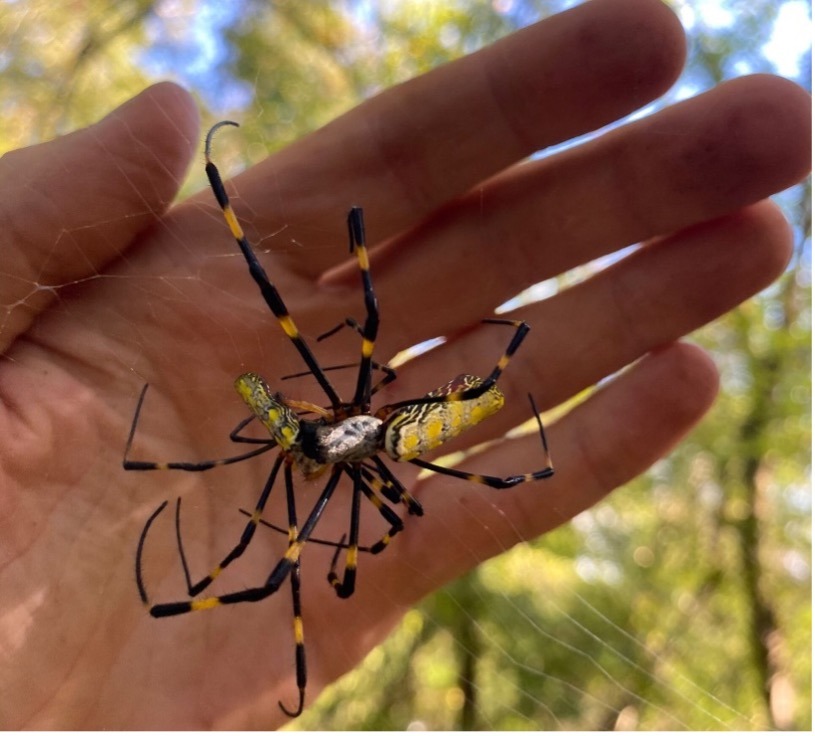
Lantern Flies: Now is the time to start squishing spotted lanternflies if you see them in Connecticut, one of 17 states where the destructive plant hoppers are established.
Other states where spotted lanternflies have been confirmed include Delaware, Illinois, Indiana, Kentucky, Maryland, Massachusetts, Michigan, New Jersey, New York, North Carolina, Ohio, Pennsylvania, Rhode Island, Tennessee, Virginia, and West Virginia, according to the US Department of Agriculture.
Adult insects have polka-dotted forewings and bold red underwings, giving them a distinctive appearance. Although it has the allure of a butterfly, the insect’s looks are deceiving. Voracious eaters, spotted lanternflies feed on about 100 plant and tree species, including economically important crops such as grapevines, apple orchards, hops ornamental landscape plants, along with multiple tree species.
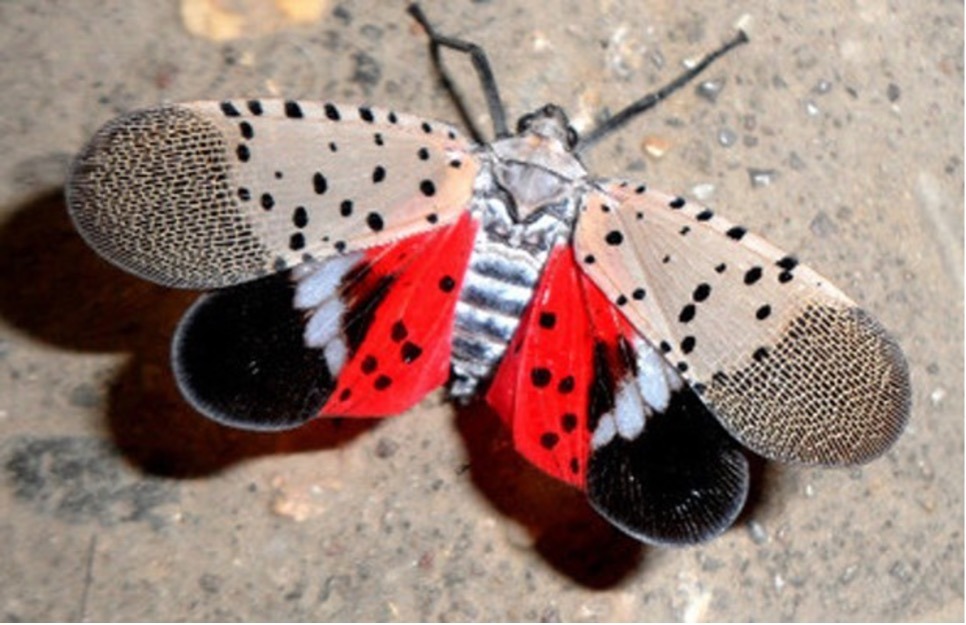
“The Spotted Lanternfly – a highly invasive insect, killing any plant it devours, was found in Lordship. If you find any, kill them by stepping or squishing. If traveling by car, please check your windshield, especially the wiper area, as this is one way the insect travels from state to state.”
Sawflies Sawflies are members of the insect order that includes ants, wasps, and bees. Sawfly adults are wasp-like and have a saw-like tube which is used to incise holes in plant tissue for depositing eggs. Unfortunately for gardeners, sawflies often lay large numbers of eggs on a single plant, and the larvae can devour large amounts of plant material in short order. Sawflies are usually plant specific, so pine sawflies may have many pines as a host plant, and rose sawflies will attack many kinds of roses, but neither will find hibiscus suitable for food. Each species of sawfly feeds on a specific host.
There are several sawfly species that are serious pests in the landscape. Be vigilant and try to detect them as soon as possible. If there are hibiscus, dogwoods, mugo pine, or roses in the garden or landscape, scouting the undersides of leaves or along needles of susceptible plants is a practical way to detect these pests early.
Rose Sawfly
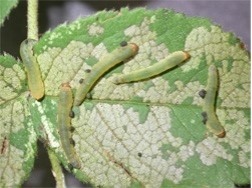
In the spring the rose sawfly can be a problem on many roses, including the insect-resistant Knock-Out™ varieties. The initial feeding damage from the smallest larval instar is sometimes mistaken for disease, as leaves turn brown over time and then curl up. The larva chew the leaves on one surface, so the other side can look good until the damage is severe enough to cause browning of leaf tissue. Most damage will end by late-June or early-July as larvae pupate. Larvae may be sprayed directly with insecticidal soap, if needed. Take care not to use any insect control products that are injurious to bees when plants are flowering. Next year, look at the leaf undersides periodically to detect larvae as soon as possible.
Hibiscus Sawfly
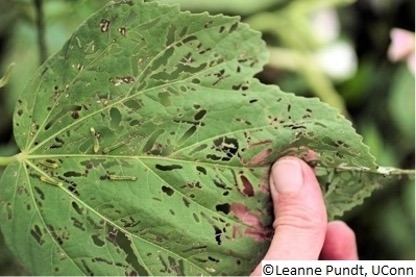
Hibiscus sawflies and damage. Leanne Pundt photo.
Hibiscus sawfly larvae feed on members of the Mallow Family. Larvae are green and have dark heads, and begin feeding on the undersides of leaves, moving to the upper sides as they become larger. To catch quickly, check the undersides of leaves. They will consume every part of the leaf except the veins, and the damage may be confused with that of scarab beetles. Manage these pests by handpicking larvae, or removing leaves having many of them. Cocoons are found on the base of the plants and can be removed and disposed. Insecticidal soaps or spinosad are effective means of control also.
Pine Sawflies
There are two species of sawfly that are serious pests of pines in New England, the redheaded pine sawfly and the European pine sawfly. The European pine sawfly commonly attacks Mugo pines in the landscape, but will also feed on Japanese, Scotch, and other pines. Usually, pine sawfly larvae are found on young trees that are between 1-14 feet tall. Damage first appears as browning of the needles and gradually the branches will become stripped of needles. This is the result of the larval habit of feeding together in large groups. If all the needles have been consumed from one tree, the sawfly larvae will move to another nearby pine. Best control is when larvae are small to keep damage minimal.
Eggs can be removed if found on needles over the winter. Destroy the material, do not simply discard on the ground. Also, clip off branches that have multitudes of larvae, or try to knock them off into a bucket of soapy water. Summer oils and insecticidal soap can be applied to larvae feeding on ornamental pines. Make sure coverage includes all the larvae.
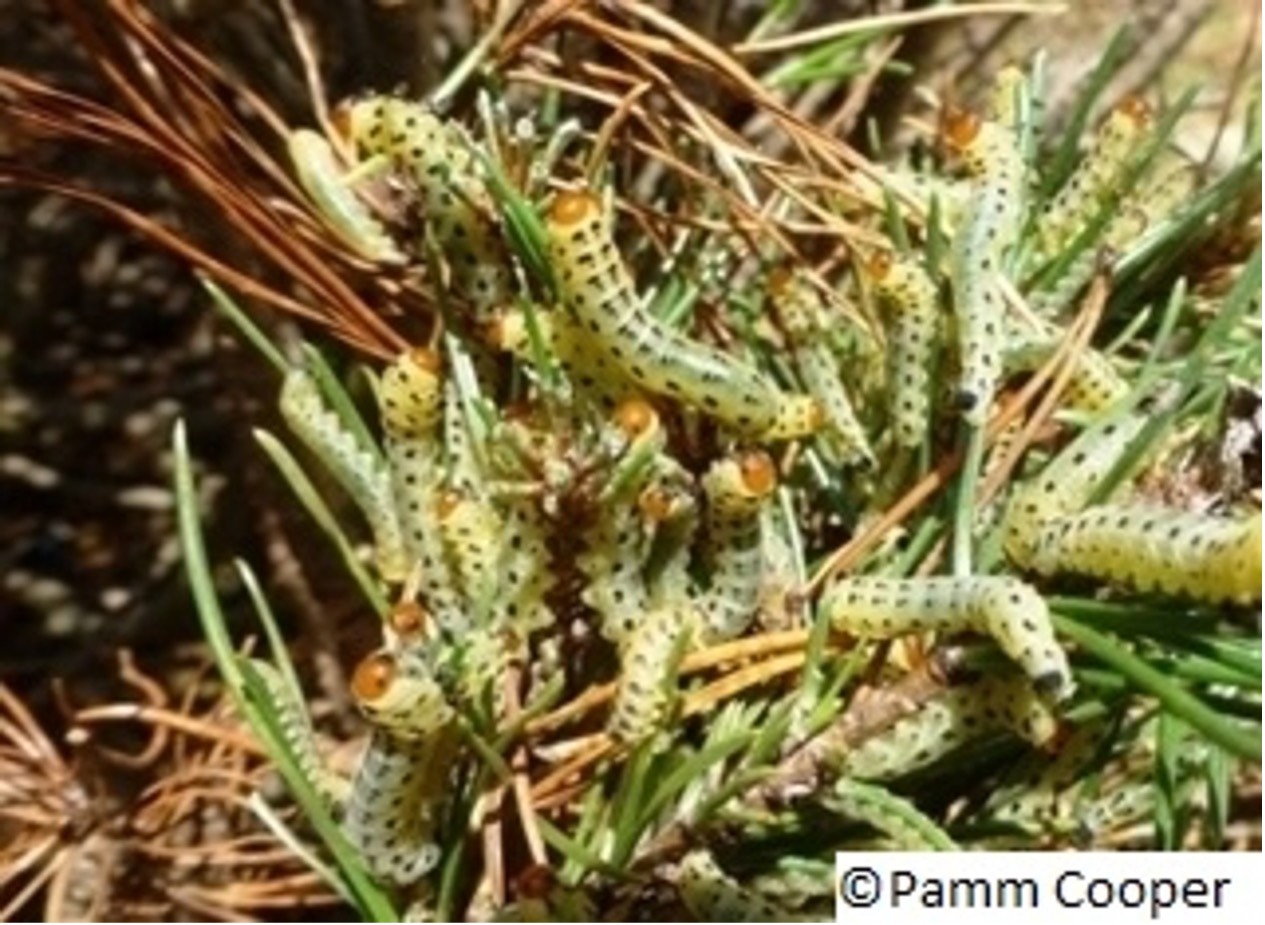
White pine sawflies, on a mugo pine.
Dogwood Sawflies
A pest of the Cornus species, the sawfly larvae can cause severe damage to the foliage of dogwoods, but seldom cause the death of the plants because defoliation occurs late in the season. Feeding takes place throughout the summer, with larval groups feeding on the undersides of leaves. Larvae have two distinct looks: one is powdery white and the other is green, black, and yellow. They rest in a curled-up position on the undersides of leaves.
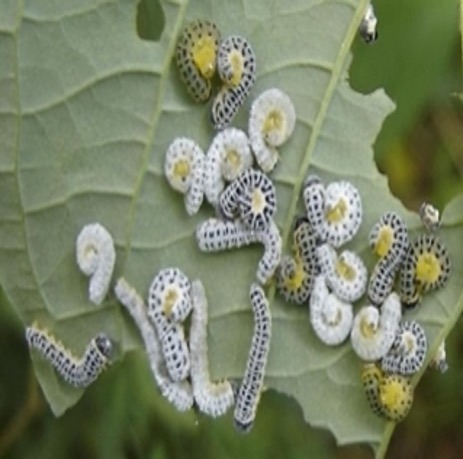
Michael Masiuk photo
When they are done feeding, dogwood sawfly larvae wander off to find a suitable place to pupate, preferring rotting wood. They have been known to bore into any wooden structure, including homes.
Sawfly adults are hard to spot as they appear to be wasps hanging about the garden. Acquaint yourself with the life cycles of the sawflies that are pests in your gardens or landscapes, and check for larva before you see damage. The smaller you find them, the easier it is to get rid of them. To control sawfly larvae, try to choose the method or product least harmful to other insects. Insecticidal soaps, horticultural oil, and pyrethrin are labeled for sawfly control.
Last, but most important….
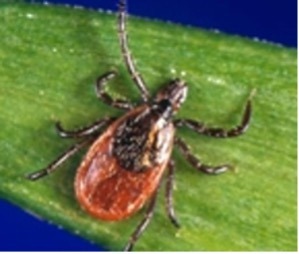
Ticks: The two species of ticks most likely to be encountered in Connecticut are the wood or American dog tick and the smaller black-legged tick, often called the deer tick as white-tailed deer are a favored host. Both carry diseases but it is the black-legged one that can transmit Lyme disease, human babesiosis and human granulocytic anaplasmosis. Late spring through summer is typically the time of year for greatest human exposure to Lyme and other tick-borne diseases. They can be active any time the temperature is above 30°F.
These parasites can feed on the blood of mammals, birds, reptiles and amphibians. We, of course, are concerned when they feed on us, our pets and any livestock. Ticks usually feed on different hosts during their various life stages. Young larvae will often feed on ground-dwelling rodents while the nymphs and adults search out larger animals including humans.
Ticks cannot jump or fly, instead they have a behavior called questing. The nymphs or adults will climb to the tips of grasses and perennials or out to the ends of shrub or young tree branches and wait in the questing position where they hold on to the plant with their third or fourth leg pair leaving their first pair of legs outstretched and ready to grab on to any bypassing animal.
They can detect animal breath and body odors. They can also sense body warmth, moisture, and vibrations from movement.
Once on their host, some ticks attach themselves immediately while others search for parts with thinner skin such as a dog’s ears. They first grasp the skin, cut into it and insert their feeding tube. It is often difficult to pull off a tick since some species secrete a cement-like substance that keeps them well attached. They can also secrete saliva with anesthetic properties that numb their bite. They may feed for several days and during this time they may also secrete saliva into the bite that contains pathogenic organisms such as Lyme disease. When full of blood, the tick drops off and prepares for its next life stage.
Personal Protective Measures
- When walking in wild areas, keep to the center of paths and avoid brushy or grassy areas.
- Wear a hat and light colored clothing so ticks will be more visible.
- Wear long-sleeved shirts and long pants tucked into boots or socks.
- Consider using a repellent at least around the bottoms of pants.
- The Centers for Disease Control (CDC) recommends the use of repellents containing 20-50% DEET on exposed skin and clothing.
- Additional repellent recommendations may be found at the CDC’s site.
- Reapply as needed.
- Permethrin may be used on clothing but not on skin.
- See the CDC’s site Preventing Tick Bites for suggestions.
- Do a thorough tick check after arriving home.
- Wash and dry clothes using hot water.
- Seek medical attention if you develop any symptoms of tick-borne diseases.
When thinking about the home landscape keep in mind that ticks live in woods and fields. They need the humidity provided by natural wild areas to survive. They will desiccate in the middle of a hot, sunny lawn. Up to 70% of ticks on residential lawns are found within 9’ of the edge of a wooded area so the key to keeping ticks out of your yard is to provide a buffer zone between these wild areas and gardens or where the kids play.
- Mailboxes, picnic tables, children’s swing sets or sandboxes and vegetable garden areas should be located in full sun as much as possible.
- Clear any brush and trim tree branches to let in more light.
- Keep these areas free of weeds, brush and leaf litter.
- Use mulches or gravel wherever possible.
- Keep the area next to woods and fields well-maintained.
- Mow regularly and keep weeds as low as possible.
- For the latest insecticide recommendations visit the Connecticut Agricultural Experiment Station Tick Management Handbook.
Tick Removal
- Immediately remove ticks using fine-tipped tweezers.
- Grasp the tick firmly as close to the skin as possible.
- Pull the tick’s body away from the skin with a steady motion.
- Clean the area with soap and water.


